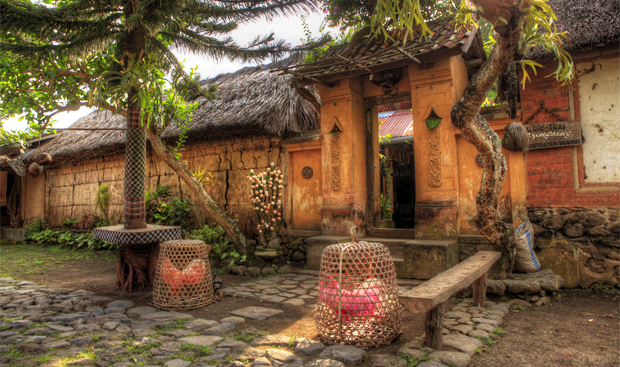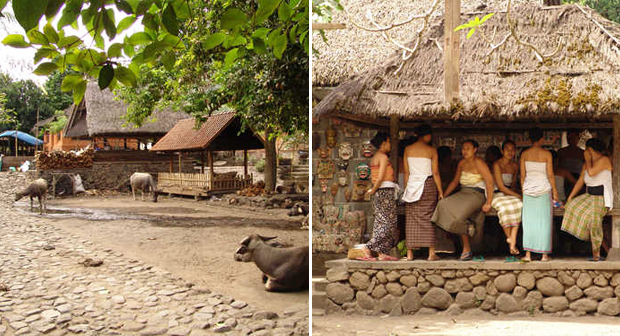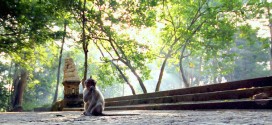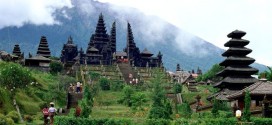
Located at northwest of Candidasa, is situated about 5km from the main road. Tenganan is a symmetrically laid out Bali Aga village with a walled homes and unique crafts. The Tenganan Village, or Tenganan Pegringsingan, is one of the ancient villages on the island of Bali. It reflects the cultural life of its people and customs of the Bali Aga Village (pre-Hindu) which was different from other villages in Bali. Therefore the Tenganan Village developed as a popular cultural tourist attraction.
The regional of this village is consisted of three complexes those are resident, plantation and rice field complex. The history of Tenganan village is expressed in a few versions. The first version is mentioned that the resident of Tenganan village are come from Paneges Village, a village is located near with Bedahulu Village that is located Gianyar Regency.The second version is expressed that word of Tenganan recognized in one of Bali inscription that was written by the word of Tranganan. The third version is expressed that the Tenganan Village Resident prays to the Bukit Lempuyang Temple.

The word of Tenganan is ascribed by a Tengah root word which can mean to aim to middle of Pegringsingan, the fasten cloth type weave that is typically produce by Tenganan village resident. The structure of resident in Tenganan village is built in linear consisted of six rays. Each of ray consisted of some lawn broadly, the building form where the local community use it to present the handicraft for tourists. All the tradition existences of the human being are harmoniously with the God, human and environment as according to Tri Hita Karana concept. The Tourism Destination of Tenganan remains to draw during the time, goodness as tourism cultural object, tourism nature and agriculture tourism.

Here we can see the way the true Balinese society live their daily lives through the traditions they hold so dear, untouched by outside cultural influences. Traditional row houses still look very well maintained, as does the village’s main town hall. It’s a remote village surrounded by hills which makes the air cool and free from pollution.
The friendliness of its people makes travelers more comfortable and they can get to really know more about Tenganan. By the side of the main streets, there are many locals (mainly men) who make and sell palm calendars that are related to Tenganan. The Tenganan calendar is made from palm leaves. Each palm leaf is arranged vertically and connected with string. At the top and bottom, there are bamboo slats to strengthen the calendar. When folded, it looks just like bamboo slats but inside it contains a calendar.
Another Tenganan attraction is the ritual tradition Mekaré-kare, also known as “Pandan War.” Mekaré-kare is the top part of the procession of the ceremony that’s held at Ngusaba Sambah each June and lasts for 30 days. For one month, Mekaré-kare is done 2-4 times and each time gifts are given to the village’s ancestors. The men are involved with Mekaré-kare from the time they are young right through until old age. As the name implies, it uses pandan leaves, cut into pieces around 30 cm, that can be used as a weapon and a shield to fend off opponents from pandan thorn scratches. Wounds caused by scratches will be wrapped with pandanus made from herbs and tubers such as Laos, turmeric and others.

Mekaré-kare is essentially the same meaning as the Tabuh Rah ceremony performed by Hindus in Bali when they hold religious ceremonies. The ceremony of Mekaré-kare is always accompanied by a gamelan Selonding.
Another great attraction unique to Tenganan, not done anywhere else in Indonesia is the creation of the double ikat weaving cloth. The word “Gringsing” comes from the word “Gering” which means sickness or accident, and “sing” which is not, so the whole word “gringsing” means to repel dangers. Making gringsing cloth is done in homes which also are used to sell the cloth. Tourists would come into the house freely without even a courteous “excuse me” or “hello.”
The Gringsing cloth-making process is unique and takes a long time to make, (up to 3 years), so it’s scarce and that also makes it expensive. Gringsing fabric must be owned by the villagers of Tenganan because it’s one of the tools used in rituals such as the cremation ceremony where gringsing cloth is placed on top of the Bade, a tool used to carry the corpse. When the cutting teeth ceremony occurs, gringsing cloth is used as the base cushion.





Hello,
We would like to go to Tenganan Pegringsingan.
Do you provide a day trip including hotel pick up in Legian and someone
who can show us the village and somewhere to eat.
Thanks
Shaun